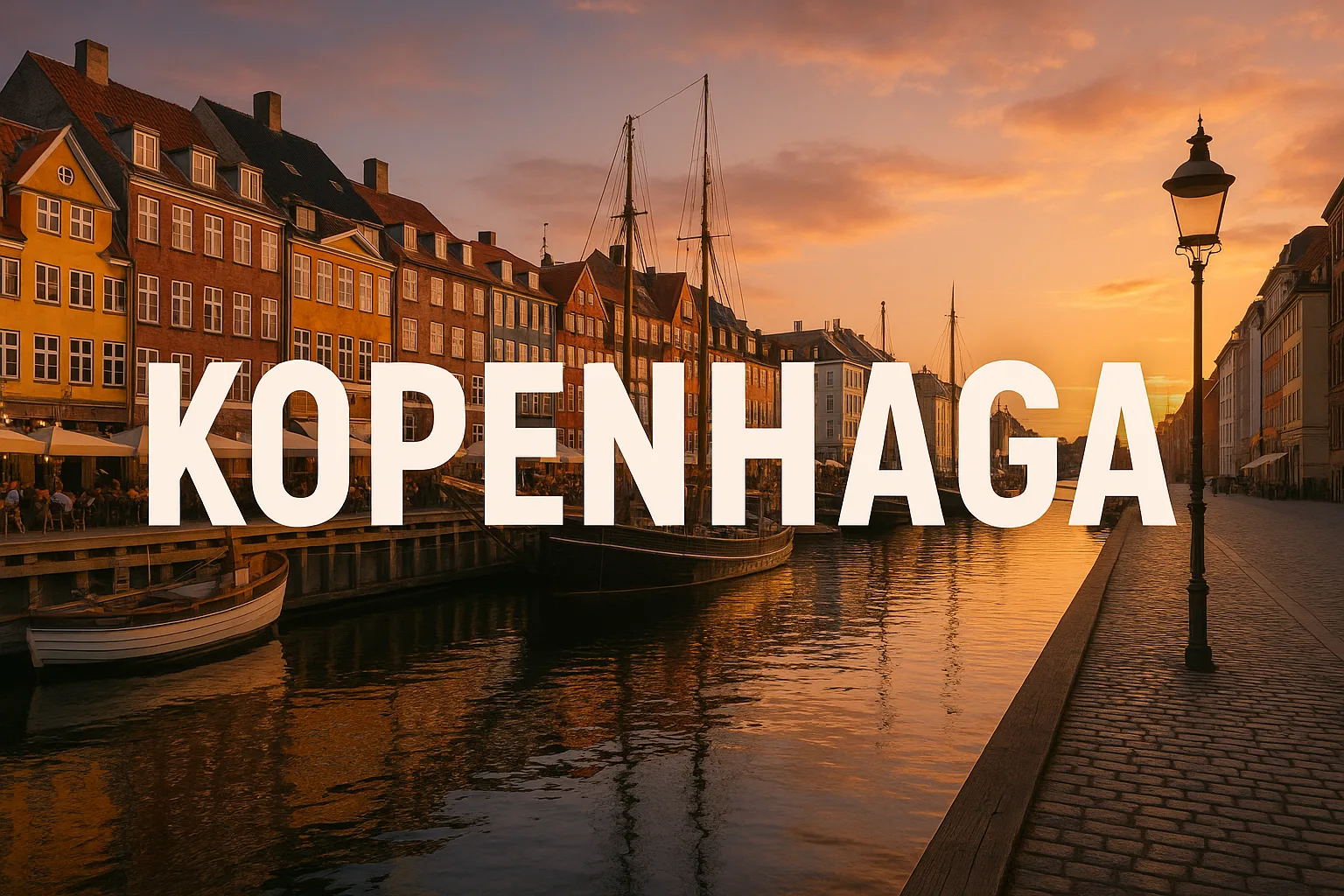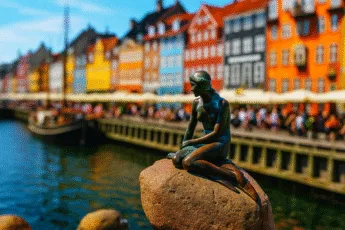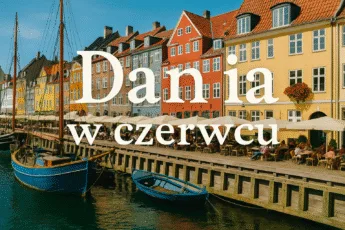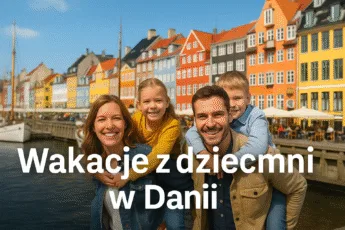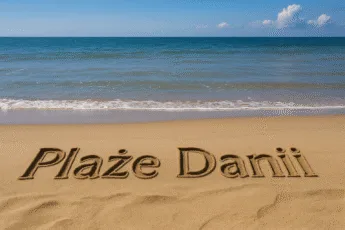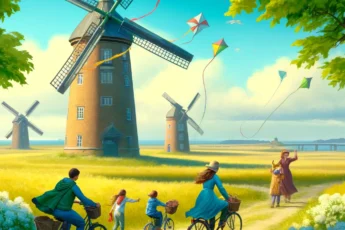The contrast between the elegance of historic palaces and the industrial climate of the Christiania district makes Copenhagen a city that cannot be easily pigeonhole. The capital of Denmark is not only a small mermaid or Tivoli gardens - it is a city functioning with watchmaking precision, which has been at the forefront of the most expensive, but also the most functional capitals of Europe for years.
In 2025, the average price of accommodation in the center exceeds 900 DKK per night , and a 24-hour ticket for public transport costs 90 DKK . It is a place where bicycle infrastructure is over 400 km , and most of the attractions are within a 15-minute walk .
This guide was created for people who want to see the most important attractions of Copenhagen without wasting time and money , with a clear division into routes, prices and practical tips. You will find only information about places checked personally or officially confirmed - without opinions from forums, without tourist clichés.
Each block contains specific proposals with addresses, hours and costs , ordered according to the location and type of sightseeing. The purpose of this guide is not only the answer to the question "what to see in Copenhagen", but also how to do it wisely - in 2025 and in the following years .
Copenhagen at first glance - what is worth knowing before sightseeing?
Planning a visit to Copenhagen requires precision - especially if you want to see key attractions without wasting time and money. This city is not accidentally considered one of the best organized in Europe. The infrastructure works on time, and the urban system facilitates the logical planning of the tour. The biggest attractions are within a few kilometers, and the urban transport system - metro, buses and queues - allows you to reach every point without a car.
How to plan a sightseeing of Copenhagen?
The most effective way of getting to know Copenhagen is a division into 3 zones: the very center (Nyhavn, Palace, Tivoli), museum areas (including Rosenborg, Designmuseum) and alternative districts (Nørrebro, Christiania). It is worth considering buying Copenhagen Card , which includes transport and over 80 attractions-the cost of the 72-hour version is 859 DKK (as of 2025). Thanks to the card, you can avoid queues and use public transport without additional fees.
How many days do you need to get to know the capital of Denmark well?
3 days are enough for a full tour of the city without rush . The first day is worth spending on classic routes: Nyhavn, Little Mermaid, Amalienborg and Tivoli. The second day - for museums and galleries (Designmuseum, Statens Museum for Kunst). The third day is recommended for less known areas such as Reffen, Superkilen or Channel Rejs. For people with a limited time, it is possible to shorten the program to 2 days, but this will require giving up some local districts.
The best months to explore Copenhagen are May, June and September . In the summer season (July -August) the city is crowded, and the prices of accommodation and tickets are rising by an average of 20-30%. April and October offer lower prices, but a shorter day and a greater risk of rainfall. In December it is worth visiting Christmas fairs, especially in Tivoli.
Copenhagen's biggest attractions - what to see?
For anyone who visits the capital of Denmark for the first time, there is a set of places that are not negotiable - they create the city's visual and cultural identity. If you are wondering what to see in Copenhagen in 2025, this part of the guide will help you choose mandatory points.
Tivoli Gardens and Little Mermaid - the symbols of the city
Tivoli Gardens is the oldest amusement park in the world operating without interruption since opening - exactly from August 15, 1843 . It is located opposite the main station (Københavns Hovedbanegård) and offers not only carousels, but also concerts, restaurants and light illuminations after dark. In the summer season (May -September) admission costs 155 DKK (without attractions), and a full package with access to devices - 355 DKK .
The little mermaid (Den Lille Havfrue) , despite the controversy in size (only 125 cm in height), is the most photographed monument in the country. It was unveiled on August 23, 1913 , inspired by Andersen's fairy tale. It is located in the port of Langelin, a 15 -minute walk from the Amalienborg Palace. The monument can be the target of vandalism - the last time covered with paint in January 2024.
Amalienborg Palace and a change of guard
Amalienborg is the official residence of Queen Małgorzata II, consisting of four identical buildings from the 18th century, surrounding the square with the monument to Fryderyk V. The daily change of the guard takes place punctually at 12:00 , but only when the monarch stays in the palace (which can be recognized by the presence of the flag on the roof). It is worth standing close to the Marmorkirken church to have the best view.
The entrance to the museum inside the palace (in Christian VIII's palace) costs 125 DKK and includes royal apartments and time exhibitions. During rush hour, tickets are better to book in advance by the Konggigeslotte.DK website - they are not available under Copenhagen Card.
- Tivoli Gardens - amusement park and cultural heart of the city
- Little Mermaid - a literary symbol and a photographic compulsory point
- Amalienborg - a monarchy at your fingertips
- Nyhavn - a historic port district with colorful buildings
- Rundetårn -17th-century observation tower with a spiral ramp
Walk around Copenhagen - the most interesting places on foot
Visiting Copenhagen on foot is not only possible, but even optimal - 75% of the main attractions are located within a radius of 2 km from Rådhuspladsen , i.e. the main square of the city. Thanks to this, most tourists give up transport in favor of walks - which also allows you to better observe the everyday life of the city.
Nyhavn, Rundetårn and botanical garden
Nyhavn is a former port district, built in the 17th century as a trade channel. Today, she is known for his Dutch -style facades and restaurants located in former magazines. The oldest house - at number 9 - comes from 1681 . In the past, Hans Christian Andersen lived here (No. 20, 67 and 18).
Rundetårn is an astronomical observatory completed in 1642 . Instead of stairs, a 210 -meter spiral ramp leads to it. The viewpoint is located at an altitude of 35 m. Admission: 40 DKK . The view covers the panorama of the entire center.
The botanical garden (Botanisk has) belonging to the University of Copenhagen is a 10-hectare area with over 13,000 plant species. Greenhouses in the Victorian style come from 1874 . Admission to the garden is free, but entering the greenhouse costs 60 DKK .
Walking route: from port to palaces
The most logical pedestrian route connects Nyhavn with the Amalienborg Palace, through the opera, the Marmorkirchen church, Plac Kongns Nytorv and ends at Christiansborg. 2.3 km long and takes about 35 minutes at a calm pace , without stopping in museums. This route allows you to see most of the most important representative buildings and state administration facilities.
It is worth walking early in the morning or after 17:00 - then crowds of tourists are smaller and the light for photos is better. The distances between the points are short, which makes the walk the perfect way of sightseeing - also in winter, provided that the weather is good.
| Route | Distance | Transition time |
|---|---|---|
| Nyhavn → Amalienborg | 700 m | 9 minutes |
| Rundetårn → Nyhavn | 1.2 km | 15 minutes |
| Botanical garden → Rosenborg | 300 m | 4 minutes |
Free attractions in Copenhagen - visit without spending
Although Copenhagen is considered one of the most expensive capitals of Europe, many public institutions and cultural facilities offer completely free access. For tourists planning a budget trip in 2025, knowledge of free attractions allows you to really save up to 300-500 DKK per day .
Free museums and monuments
The biggest surprise is the National Museum , which offers free admission every Wednesday from 17:00 to 20:00. During this time, both permanent and time parts are available. Another example is the Military Museum (Tøjhusmuseet) , which has permanent, free access to the exposure of weapons and the history of the Danish army.
It is also worth mentioning the SMK National Gallery , which allows free access to permanent exhibition for all visitors up to 18 years old. Adults will pay 120 DKK, but the ticket also includes the entrance to the Glyptoteket Sculpture Park if it is used on the same day. In addition, the Copenhabian town hall (Rådhus) offers free access to the main hall and astronomical clock Jens Olsen.
Viewing points and walks around the districts
Free viewpoints are not rare in Copenhagen. The church of our Savior (Vor Frelsers Kirke) charges the fee for entering the tower (65 DKK), but the Royal Library "Black Diamond" and Taras of the Copenhagen University are available free of charge and offer a view of the port and city center. In the Nordhavn district, viewing platforms are available at former port silos - completely free.
A walk around Christiani is an experience in itself. Although many people associate her with controversies, one of the few places in Western Europe, where the inhabitants created an autonomous estate with their own principles. Entering the area is free, but it is forbidden to take photos in the central part. In turn, the Nørrebro and Vesterbro districts offer numerous murals and artistic installations in public space.
It is worth planning free attractions in advance. On Wednesdays after 17:00 : National Museum, town hall. Every day: Christiania, Royal Library, Botanical Garden (external part), street exhibitions in Nørrebro. Entrance to most churches - also free.
Visiting Copenhagen with a child - family attractions
Planning visiting Copenhagen with a child in 2025 does not require compromises between quality and availability. The capital of Denmark offers educational, entertainment and sensory attractions, which are not "by the way" for children - but designed for them from scratch. Prices, infrastructure and communication are adapted to the needs of families.
Zoo, aquarium and an experimentarium
Københavns Zoo is one of the oldest zoo in Europe - open in 1859 . It currently covers 11 ha, and its main attraction is a glazed pavilion with polar bears and a catwalk for elephants designed by Norman Foster. A ticket for an adult costs 239 DKK , a child 3-11 years - 149 DKK .
Den Blå Planet , the largest aquarium in North Europe, has 53 tanks, including an ocean tunnel and an interactive touch zone. Tickets: 185 DKK (child) , 205 DKK (adult) . There is a restaurant and a place for feeding infants.
The Experimentarium in Hellerup is 3 floors of interactive installations in the fields of physics, chemistry and senses. Children test here acoustics, kinetic energy and VR. Tickets: 185 DKK (children and adults) . There is also a water play zone and a cafe with a panoramic view of Øresund.
Where to eat and rest with your child?
In the center, places with a flexible menu and children's zone work best. Grød (Rosenborggade 7) serves sweet and salty porridge, and the children's portion costs 35–45 DKK . Torvehallerne is a indoor market with a dozen gastronomic points and an inner sitting zone.
To rest away from the hustle and bustle, Frederiksberg Have Have with a large picnic zone and Superkilen - a park in Nørrebro with interactive sculptures and a skatepark. Both places are available free of charge and adapted to prams.
- Københavns Zoo , Roskildevej 32 - daily 10: 00–18: 00
- Den Blå Planet , Jacob Fortlingsvej 1 - 10: 00–17: 00 (PT -ND until 20:00)
- Experimentarium , Tuborg Havnevej 7 - 09: 30-17: 00 (SB -ND until 18:00)
- Grød , Rosenborggade 7 - 08: 00–20: 00
- Superkilen , Nørrebrogade - park is open around the clock
🔗 See also: Holidays with children in Denmark - attractions, zoo, parks and interesting places
Unusual attractions of Copenhagen - something outside the scheme
In addition to classic palaces and museums, Copenhagen has places that you will not find on tourist folders. For those who want to see the city outside the scheme, it is worth spending a few hours on less obvious routes. Most of them are available free of charge and do not require prior booking.
Christiania district and local street art
Christiania was founded in 1971 in the former Bådsmandsstræde barracks and functions as a community independent of the city authorities, although it is formally part of Copenhagen. 850 people live here . The area is open every day until dusk, free admission. There is an absolute ban on photographing in the so -called Green Light District. On weekends, crafts and improvised concerts are organized.
Copenhagen street art is concentrated in the districts of Nørrebro and Vesterbro . It is worth seeing the works of the Danish artist Huskmitnavn (including the mural at Blågårdsgade 9) and large -format graphics "The Wall" at Enghaveve. Most of the works are legal and documented by the Municipal Archives of Municipal Art.
Less known but worth visiting space
Cisternerne - former underground water reservoirs in Frederiksberg transformed into an exhibition space - this is one of the most unique places in Europe. A constant temperature of 16 ° C and humidity above 90% create ideal conditions for installation art. Tickets: 130 DKK , exhibitions change every 6 months.
Reffen - a container Street Food zone with over 40 stands and craft workshops - works seasonally (April -September) at Refshaleøen. Free admission, prices of dishes: 50–90 DKK. On Fridays and Saturdays, Silent Disco and Outdoor Cinema take place here. This is a space for those who wonder what to do in Copenhagen in the evening outside of classic routes.
If you are planning a weekend in Copenhagen outside the beaten trail, plan: a walk around Christiania (9: 00 - switch), a visit to Cisternerne (11: 00–18: 00, with a ticket), dinner in Reffen and the evening show of an outdoor film. All places are served by city transport with a change in Christianshavn.
The best Copenhagen Museums - art, history and design
The Copenhagen Museum offer is over 60 institutions - from classical art to an experimental design. In 2025, many of them are covered by the Copenhagen Card , which allows you to realistically save with intensive sightseeing. Some institutions also offer free entrances on specific days or hours.
National Museum and Design Museum
Nationalmuseet , or the Danish National Museum, is located at NY Vestergade 10. The main permanent exhibition includes the history of Denmark from the stone era to the present day - including the unique collection of Viking era items. A normal ticket costs 130 DKK , children up to 17 years old - free of charge. On Wednesdays from 17:00 to 20:00 the entrance is free.
Designmuseum Danmark , located at Bredgade 68, has collections of Scandinavian design from the 20th and 21st centuries, including Arne Jacobsen furniture and Poul Henningsen lamps. After a thorough renovation in 2022, the museum gained a new permanent and digital educational center. Admission: 135 DKK , free of Copenhagen Card.
Museums from Copenhagen Card
Copenhagen Card in the 72-hour variant costs 859 DKK and includes admission to over 80 museums and attractions in the capital region. The most important objects covered by the card include: SMK (Statens Museum for Kunst), Glyptoteket, Thorvaldsen Museum, Cisternerne, Viking Museum in Roskilde. The card also provides an unlimited number of journeys by public transport.
In practice, buying a card pays off when visiting 3-4 museums a day. However, it is worth checking the opening hours - some facilities, such as the Sailing Museum, are closed on Mondays. The card can be bought online or at the airport (terminal 3, DSB point).
| Museum | Fare | Free admission days | Included in Copenhagen Card |
|---|---|---|---|
| Nationalmuseet | 130 DKK | Wednesdays 17: 00–20: 00 | ✔ |
| Designmuseum Danmark | 135 DKK | Lack | ✔ |
| SMK - Statens Museum for Kunst | 120 DKK | Until 18 years of age - always free | ✔ |
Visiting channels - Copenhagen from a water perspective
The Copenhagen channel system is over 42 kilometers of navigable routes crossing historical districts. The cruise on the channels is not only a scenic attraction - it is a logical and practical form of sightseeing with a guide , available daily, throughout the season from April to October. Most of the boat flows from the Nyhavn or Gammel Strand .
Boat and boat cruises with a guide
The most popular is the route supported by DFDS Canal Tours , lasting 60 minutes. It starts every 30 minutes from 9:00 to 18:00 (in the summer season - until 20:00). Ticket cost: 109 DKK (adults) , 51 DKK (children 6-15 years old) . The price includes a guide in Danish, English and German. Tickets can be bought online or directly at the ticket office.
The option of cruises with local guides on Christianshavn and Refshaleøen channels, offered by Hey Captain . Smaller boats (max. 12 people), individual approach, the ability to ask questions during the cruise. Cost: 250–300 DKK . Copenhagen card does not apply in this formula.
The most interesting water routes in the city center
The most scenic route includes sections around Nyhavn, Opera, Amalienborg Palace and the Royal Library . The boats also flow under the 17th-century bridges and next to modern Scandinavian architecture buildings, such as Blox or Nykredit Cube. The route is architecturally diverse and covers the city's key points, which from the water level look completely different than from the land.
The cruise does not require prior reservation, but on weekends it is recommended to buy an online ticket due to high occupancy. The boats are roofed and heated - also available on days with light rain. All companies offer rescue vests and support for people with limited mobility.
- DFDS Canal Tours (Start: Nyhavn/Gammel Strand) - 109 DKK, daily 9: 00-18: 00
- Hey Captain (Start: Ophelia Plads) - 250-300 DKK, cruises every hour, 10: 00–19: 00
- Goboat (rent without a guide) - from 495 DKK for 1h / 8 people, start: Islands Brygge
Copenhagen Card - is it worth buying a tourist card?
Copenhagen Card is an official tourist card of the capital region of Denmark, including not only admission to museums, but also unlimited access to public transport. In 2025 it is available in: 24h, 48h, 72h, 96h and 120h versions. The most popular option-72-hour-costs 859 DKK (adults) and 429 DKK (children 3–11 years) . The card includes metro, buses, trains (including airport), 88 museums and attractions, as well as selected cruises on the channels.
What does it cover and how much does it cost?
All card variants cover the same range of attractions - they differ only in the length of expiry. Purchase of the card is possible online (Copenhagen Card application or e-mail PDF), at tourist information points and at Kastrup airport. Prices in 2025:
- 24h - 469 DKK (adult), 235 DKK (child)
- 48h - 699 DKK (adult), 349 DKK (child)
- 72h - 859 DKK (adult), 429 DKK (child)
- 96h - 999 DKK (adult), 499 DKK (child)
- 120h - 1099 DKK (adult), 549 DKK (child)
The card is activated automatically at the first use - not earlier. You don't have to print it - all you need is the QR code on your smartphone.
What attractions do you get into the package?
As part of Copenhagen Card, there are:
- Tivoli Gardens - basic admission (without bands for attractions)
- Nationalmuseet , Designmuseum Danmark , SMK , Glyptoteket
- Cruise on DFDS channels with a guide (NYHAVN or Gammel Strand)
- Viking Museum in Roskilde - full access to exhibitions and workshops
- Rundetårn , Christiansborg Slot , Rosenborg - entrances to palaces and towers
Full list available at: Copenhagencard.com
when buying a 72H card (859 DKK), the cost of visiting the 4 most frequently chosen attractions would be: Tivoli (155 DKK), SMK (120 DKK), DFDS cruise (109 DKK), Designmuseum (135 DKK), transport 3 days (270 dkk) = 789 DKK . By adding Rosenborg (125 DKK), the balance becomes beneficial. The card pays off with active sightseeing min. 3 objects per day.
Transport in Copenhagen - Metro, bikes and on foot
Copenhagen has one of the most functional communication systems in Europe. In 2025, the transport infrastructure includes 4 metro lines, a dense bus and S-TOG rail network, as well as over 400 km of bicycle routes. The whole city is divided into tariff zones - most attractions are located in zone 1–3.
Metro, buses and how to move around the city
The metro in Copenhagen operates 24 hours a day, all year round. M1 -M4 lines support 39 stations and provide connection with the airport, center, districts of Ørestad and Nordhavn. Trains run every 2-4 minutes during rush hour. Transfer on the airport - Kongens Nytorv route lasts 13 minutes.
The price of a 2-zone (most commonly used) ticket: 24 DKK . 24-hour ticket (all zones): 90 DKK . Tickets are available by the Dot or in ticket vending machines. The Rejsekort card for residents does not apply to tourists. All means of transport are integrated in one system - one ticket includes a subway, buses and trains.
Copenhagen by bicycle - ideal conditions
In 2023, as many as 49% of the inhabitants commuted every day to work or school by bike . Copenhagen has over 400 km of dedicated bicycle paths, physically separated from the road. The bike can be rented under the Donkey Republic system - cost: 20-30 DKK for 30 minutes or 115 DKK per day . Stations are available every 300 meters.
A bicycle can be moved around the center, and recreational routes are designated along the main channels. The transport of the bike in the subway and DSB trains is free outside of peak hours (7: 00–9: 00, 15: 30-17: 30). The city provides free racks, repair stations and bicycle parking lots at each transport node.
| Service | Price (DKK) | Time / range |
|---|---|---|
| 2-zone ticket | 24 DKK | 1 hour |
| 24-hour ticket (all zones) | 90 DKK | Metro, buses, trains |
| Bicycle rental (Donkey Republic) | 115 DKK/Day | all of Copenhagen |
| Metro: Airport - Centrum | 24 DKK | 13 minutes |
Copenhagen districts - what is worth visiting outside the center?
In addition to the very center of Copenhagen, there are districts that not only develop dynamically urban planning, but are a real source of knowledge about Danish architecture and Nordic culture . From historical Frederiksberg to Multicultural Nørrebro - each district has a separate identity, well documented and available without fees.
Nørrebro, Vesterbro and Frederiksberg
Nørrebro is the most socially diverse district of the city. The main artery - Nørrebrogade - is full of independent bookstores, cafes and Zero Waste stores. In Superkilen Park there are 108 facilities from different countries of the world - from Moroccan fountains to Japanese benches as an expression of the district multiculturalism.
Vesterbro underwent a radical transformation after 2000. The district, formerly associated with industry and prostitution, today offers art galleries (e.g. V1 Gallery), wine bars, ecological bakeries and coworking spaces. Istedgade Street is a place for those who are looking for an alternative look at Copenhagen outside the beaten trail .
Frederiksberg is an administrative enclave separate from Copenhagen, but completely spatially integrated. The district dominated by the green spaces - Frederiksberg Have , the palace garden from the 18th century, and the Museum of Contemporary Art. The building style is classic
Culinary and cultural pearls of local districts
In Nørrebro there is Jægersborggade - a street known from micro -carriers, natural winery and specialty cafes. It is worth visiting "The Coffee Collective" - one of the best rated roaster in Scandinavia. Coffee: 35–45 DKK , Tasting on booking weekends.
Vesterbro offers meatpacking district (Kødbyen) - a former slaughterhouse complex transformed into a space and gastronomy space. There are, among others Restaurants Bio Bio and Kødbyens Fiskebar. In the evenings live concerts are organized, usually free admission with a table booking.
In Frederiksberg it is worth seeing VærnedamsVej - a street connecting the French style with Danish - full of bakery, artistic bookstores and boutiques. This is one of the best -rated "Slow Strets" in Copenhagen according to the Copenhagenize Index data.
• The Coffee Collective - Jægersborggade 10
• Prolog Coffee Bar - Høkerboderne 16 (Kødbyen)
• Rist Kaffebar - Værnedamsva 4b
• Lyst - cafe + art gallery, blågårdsgade 23
all places from the morning to the morning to 17: 00–20: 00, most with free Wi-Fi and vegan menu.
12. Where to eat in Copenhagen - the flavors of the city
Copenhagen is one of the most important places on the gastronomic map of Europe - with over 20 restaurants with Michelin star and the extensive Street Food scene. But food in the capital of Denmark is not only haute cuisine - it is also a hygge culture at the table, shared lunch and local ingredients. In 2025, the average lunch price in the center is 85–120 DKK , and dinner at a restaurant with service - 200–400 DKK .
Traditional dishes and modern cuisine
The classic dish, which you will find in almost every traditional restaurant, is Smørrebrød - open sandwiches on rye bread, with smoked herring, liver pate or rostbef with marinated onion. The basic versions cost from 30 to 70 DKK per item.
The new culinary scene is focused on fermented vegetables, silage and wild herbs. Local examples of a modern approach to Danish cuisine are, for example, Restaurant Høst (Nørre Farimagsgade 41) - tasting menu 3 dishes: 395 DKK . Recommended booking 2-3 days in advance. Some of the restaurants sell online tickets for thematic dinners - details for: madbillet.dk.
The best places for lunch and dinner
For lunch in the center, you should consider Torvehallerne - an indoor market with over 60 stands. Popular points are Hallernes Smørrebrød and Grød (groats with accessories). Lunch portions: 65–90 DKK . For dinner: kødbyens fiskebar (Vesterbro) - specialization in seafood, prices of main dishes from 175 DKK .
If you are looking for a full experience of Hygge , with soft light, candles and interiors in the Scandinavian style -: Café Det Vide Hus (Blågårdsgade), Atelier Sepbember (Gothersgade) and Granola (Værnedamsva). They all offer breakfast throughout the day, vegetable alternatives and hand -baked coffee.
- Torvehallerne - Frederiksborggade 21, 10: 00–19: 00 (SB until 18:00)
- Høst - Nørre Farimagsgade 41, from 17:00, seasonal menu
- Fiskebar - Flæsketorvet 100, 12: 00–22: 00
- Café Det Vide Hus - Blågårdsgade 26, 09: 00–20: 00
- Atelier Seprsege - Gothersgade 30, 08: 00–17: 00
🔗 See also: What to eat in Denmark? Traditional dishes, prices and where it's worth a try
Cheap weekend in Copenhagen - how to save?
Despite the high costs of life, a cheap weekend in Copenhagen in 2025 is possible - provided that pre -planning and knowledge of local systems. The average budget for 1 person for 2 days can be closed in about 850–1100 DKK , if you use free attractions, cheap accommodation and tickets in advance.
Free events and cheap accommodation
Every Friday evening at the Statens Museum for Kunst and Glyptoteket there are free concerts or audiovisual shows - entrance without tickets, limited to 200 people. In summer, Islands Brygge and Fælledparken offer free yoga and street dance classes.
The cheapest accommodation in the center of Copenhagen is hostels with multi -person rooms . Example: Urban House Copenhagen by Meininger , Vesterbro - bed in the dormitory from 179 DKK per night (when booking online min. 14 days earlier). Alternative: Sleep in Heaven (Nørrebro) - from 159 DKK , free coffee and coworking zone included.
Promotions, tickets in advance, applications
Many museums and attractions offer discounts up to -25% when buying tickets at least a week in advance on official websites (e.g. designmuseum.dk , visitcopenhagen.com ). Time promotions also appear in applications: Too Good to Go (for cheap food), Dot Tickets (Transport) and Billetto (Events).
On weekdays (PN -CZW), tickets for channel cruises are cheaper by an average of 15-20 DKK . It is also worth looking for free events on the city's website - KK.DK , in the "Free Aktiviteter" tab. Bicycle applications (e.g. Donkey Republic) also have weekend discounts - a bike for 2 days is 99 DKK .
| Expenditure | Price (DKK) | Comments |
|---|---|---|
| Accommodation (2 nights) | 318–358 | hostel, a multi -person room |
| Transport (48h ticket) | 180 | All zones |
| Food (2x lunch, 2x dinner) | 300–400 | stands + bars |
| Attractions (2 paid + rest free) | 100–160 | cruise + museum |
Copenhagen in 2-3 days - ready tour routes
If you are planning a weekend in Denmark , a well -designed route will allow you to see the most important points without rush and queues. Copenhagen can be visited on foot, supporting with a subway or bike. Below are two complete programs - one for architectural and history enthusiasts, the other for families with children or travelers looking for a light form of sightseeing.
A route for history and architecture lovers
Day 1: Start at Rundetårn (9:00), then a walk to the Vor Frue Kirke cathedral , then Strøget to the Ratuszowy Square . In the afternoon: Christiansborg Slot and observation deck (Introduction: 105 DKK). In the evening, dinner at Det Gamle Apotek - a historic restaurant at Kompagnistræde.
Day 2: Morning walk with a guide around the Frederikstaden district (Amalienborg, Marmorkirchen), then Designmuseum Danmark . In the afternoon: Glyptoteket , and at the end of the day - sunset from the terrace of the Royal Library .
Day 3 (optional): Cruise on Nyhavn channels (DFDS, 109 DKK), visit to Rosenborg Slot with royal crowns and a short walk around the botanical garden .
Route for families with children and at ease
Day 1: Start in Tivoli Gardens (opening: 11:00), lunch in the Food Court at the entrance, then Nationalmuseet with an interactive exhibition for children (free of charge until 17 years of age). In the evening a walk to the town hall and LuR Fountain.
Day 2: Bicycle rental (Donkey Republic, 99 DKK/day), detour through Superkilen , Reffen and Lunch in the Gastro container zone. In the afternoon: Den Blå Planet - the largest aquarium in Scandinavia (ticket: 205 DKK). Dinner at Grød on Jægersborggade.
Day 3 (optional): Morning visit to the Copenhagen Zoo or Experimentarium . Alternatively: picnic at Frederiksberg Have and Relaxing over the channels.
Avoid Sunday evenings - many museums close earlier or does not work on Mondays. It's best to start visiting on Friday afternoon and end on Sunday until 16:00. Book attractions in advance by official websites ( visitcopenhagen.com ).
What to see around Copenhagen - one -day trips
For those who have more than 2 days in Copenhagen, one -day trips outside the city . The Zealand region offers access to castles, Gothic cathedrals and the longest Scandinavia bridge. All goals below are available in less than 1.5 hours by public transport and do not require accommodation.
Kronborg Castle, Roskilde and the Øresund bridge
Kronborg Slot in Helsingør - known as Hamlet Castle - is located 45 km from Copenhagen. From the main station, the train commutes in 47 minutes , ticket cost: 98 DKK (back and back) . Castle is open daily 11: 00–17: 00, tickets: 145 DKK , including entrance to the tower and underground.
Roskilde is the former capital of Denmark and the royal headquarters. The most important points: the cathedral in Roskilde (UNESCO) and the Viking Łódź Museum . Access by train from København H: 23 minutes . Normal return ticket: 96 DKK . Admission to the museum: 160 DKK . In the season possible cruise with Łódź Wikińska (surcharge: 80 DKK).
The Øresund bridge is a technical icon of the region - connecting Copenhagen with the Swedish Malmö. The Øresundståg train ride lasts 35 minutes , one way ticket price: 99 DKK . Tickets available by the DSB or SJ application. On the Swedish side, it is worth visiting the Västra Hamnen district and Turning Torso viewpoint.
How to plan a one -day trip?
It's best to go between 8:00 and 9:00 , which gives a comfortable tour and return to Copenhagen before 18:00. Trains for Helsingør and Roskilde run every 20 minutes - there is no need to book. Tickets can be bought in vending machines or via the app. At Øresund it is worth booking a place in advance during rush hour (16: 00-18: 30).
In all locations, luggage compartments, gastronomic points and tourist information are available. Most attractions accept payments only by card - cash is unnecessary.
| Objective | Travel time | Ticket price (RT) | Visiting hours |
|---|---|---|---|
| Kronborg Castle | 47 minutes | 98 DKK | 11:00–17:00 |
| Roskilde | 23 minutes | 96 DKK | 10:00–17:00 |
| Øresund / Malmö bridge | 35 minutes | 198 DKK | all day |
FAQ - the most frequently asked questions about visiting Copenhagen
Copenhagen is a city built for intelligent sightseeing: easy to navigate, full content, and at the same time also available to travelers with a limited budget. Regardless of whether you choose a weekend in a spirit of design and history, or a family trip with children - the capital of Denmark in 2025 offers ready solutions that work. Just plan, book and ... go on foot.
